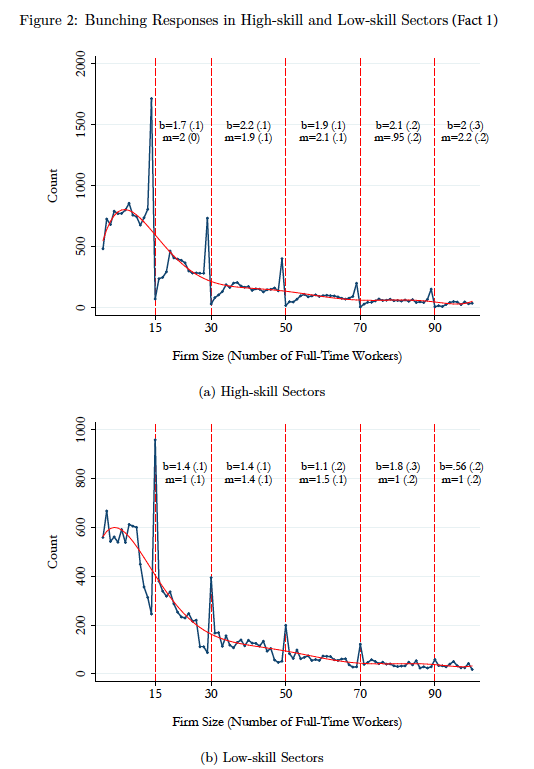Young workers make up a growing share of the labor force, while formal employment opportunities are limited, especially for those without college education. One way to address this issue is with apprenticeships, which combine formal vocational education and training within firms. The main objectives of such programs are to upgrade the skills and increase the productivity of young workers, and to help them acquire early labor market experience. Expanding apprenticeship programs is a common policy recommendation in order to tackle youth unemployment. These programs rely on firms’ willingness to employ and train unskilled workers. However, firms may lack the incentives to take on apprentices, as firm production might not be enough to offset the cost of training them.
In BSE Working Paper No. 1204, “Unwilling to Train? Firm Responses to the Colombian Apprenticeship Regulation,” authors Santiago Caicedo, Miguel Espinosa, and Arthur Seibold investigate firm responses to apprenticeship programs and how firms can be effectively incentivized to train apprentices. To do so, they study a large-scale change in apprenticeship regulation in Colombia. Guided by this empirical evidence, the authors develop a parsimonious model of firm production featuring heterogeneous costs of training apprentices, in order to uncover firms’ underlying training costs. They then use the structural model to quantify the effects of the regulation in partial and general equilibrium and to simulate counterfactual policies. Crucially, the paper documents important heterogeneity in firm responses to apprenticeship regulation and uncovers the underlying training costs of such programs.
The case of apprenticeships in Colombia
In the early 2000s, Colombia experienced high levels of informality and youth unemployment: youth unemployment rates were around 30% and youth informality rates above 70%. To address these issues a market reform was introduced in 2003. The reform required firms to train apprentices between a minimum and maximum quota depending on their size. Also, it changed apprentices’ minimum wages and introduced the possibility for firms to pay a costly fee as a “buy-out” from training apprentices.
Even though the reform is successful in expanding overall apprenticeship training, the authors document strong heterogeneity in responses across sectors. In particular, firms in sectors with high skill requirements tend to avoid training apprentices, while firms in low-skill sectors seek apprentices. Hence, while the overall number of apprentices increases sharply, most training occurs in low-skill sector firms.
The empirical findings are summarized in Figure 1. It shows that the policy expands apprenticeship training, dramatically increasing the total number of apprentices. Before the reform, there are around 0.3 apprentices per 100 full-time workers, and this increases by an order of magnitude to around 5 apprentices per 100 full-time worker after the reform. However, the regulation also induces changes in the firm size distribution by setting apprentice quotas as a function of the number of full-time workers. Panel (b) shows that such distortions in the post-reform number of full-time workers are sizeable. In the pre-reform years 1995 to 2002, the firm size distribution is relatively smooth. In contrast, the post-reform distribution in the years 2003 to 2009 exhibits pronounced spikes around the regulation thresholds marked by the dashed vertical lines, and holes or “missing mass” on both sides of the thresholds.

Notes: Panel (a) shows the number of apprentices per full-time worker in the full sample. Panel (b) shows the distribution of full-time workers for all firms before (1995-2002) and after the reform (2003-2009), using a bin size of one.
Colombian firms’ apprenticeship policy responses in three facts
The key finding of the paper is the heterogeneity in responses across firms and sectors. Such heterogeneity can be categorized into three empirical facts, related to firm-size distributions, apprentice intake by firm size, and the fraction of firms paying fees in each sector.
1. Firms in high-skill sectors bunch below the thresholds, while firms in low-skill sectors bunch at the thresholds.
Figure 2 shows that some firms in high-skill sectors reduce the number of full-time workers to avoid the higher minimum apprentice quota that would apply above the thresholds, such that they have to train fewer apprentices. Low-skill sector firms, on the other hand, increase the number of full-time workers in order to increase their maximum apprentice quota, such that they can train more apprentices.

Notes: Distribution of the number of full-time workers in high-skill and low-skill sectors post-reform (2003-2009), using a bin size of one. The dashed vertical lines denote the regulation thresholds. The solid red line shows the fitted counterfactual density. Excess mass b and missing mass m is reported at each threshold, with bootstrapped standard errors in parentheses.
2. Firms in high-skill sectors tend to choose the minimum number of apprentices while firms in low-skill sectors tend to choose the maximum.
The analysis shows that the number of apprentices by firm size in high-skill and low-skill sectors, as well as the minimum and maximum apprentice quotas from the regulation. The authors study reveals that firms in high-skill sectors have an average number of apprentices below the minimum quota of the regulation. Thus, some of these firms must be paying the fee or not comply with the regulation. In contrast, firms in low-skill sectors have an average number of apprentices close to the maximum quota, indicating that some of them may be bounded by this upper limit.
3. Only high-skill sector firms tend to pay the fee.
In high-skill sectors, around 60% of firms choose to pay the fee instead of training the minimum number of apprentices required. Note that the nominal cost of hiring an apprentice is smaller (50% to 75% of the minimum wage) than the fee (100% of the minimum wage). Thus, the responses of high-skill sector firms indicate that their training costs must be high. In fact, apprentices must create an overall negative marginal benefit for many firms, as they are unwilling to hire apprentices even though it is nominally cheaper than not hiring apprentices.
A model of heterogeneous training costs
Motivated by the aforementioned differential firm responses to the reform observed in the data, the paper introduces a theoretical framework with firm heterogeneity to capture such patterns. Firms in the model differ in two dimensions: their costs of training apprentices and their managerial ability. The training costs come from a sector-specific distribution and explain the heterogeneous firm responses uncovered by the reduced-form analysis, while managerial ability gives rise to the firm size distribution.
The model fits the three facts very well. High-skill sector firms with high training costs avoid apprentices, while low-skill sector firms with low training costs seek them. Moreover, the model highlights the initially high minimum wage for apprentices as an important source of inefficiency contributing to the low levels of training before the reform and it captures the incentives high-skill firms have to bunch just below the threshold, and that of low-skill firms to bunch at the thresholds.
As to the number of apprentices by firm size, high-skill sector firms choose an average number below the minimum quota, while the number is close to the maximum quota for firms in low-skill sectors. Finally, the simulated model also replicates empirical fact 3, with around 60% of firms in high-skill sectors with more than 15 workers choosing to pay the fee. Meanwhile, as in the data, almost none of the low-skill sector firms pay the fee and the fraction is relatively flat in firm size.
Implications for apprenticeship policy design
To complete the investigation, the authors use the structural model to quantify the effects of the regulation in partial and general equilibrium and to simulate counterfactual policies. The results suggest positive overall welfare effects of the apprenticeship program that could be further enhanced by considering heterogeneity across sectors. In fact, authors argue that widening the scope of apprenticeship training can have potentially large positive effects on the welfare of apprentices, on firms, and on aggregate production. The apprenticeship regulation creates winners and losers. Most directly related to the goal of improving young individuals’ opportunities, apprentices benefit from the regulation in all sectors and under all scenarios. On the firm side, the effects vary by sector: most low-skill sector firms see an increase in profits, as they are able to hire productive apprentices at relatively low wages. The main losers from the expansion of apprenticeships are incumbent trained workers, especially in low-skill sectors.
The paper conclusions then have important policy implications. First, given the large training costs many firms face, purely price-based interventions such as training subsidies would have to give sizable incentives to firms to achieve a broad increase in training. The Colombian regulation, featuring a mixture of apprentice quotas and lower minimum wages, does achieve a large increase in the number of apprentices, but it induces firm-size distortions and some reallocation towards low-skill sectors. Second, policies that take into account heterogeneity in training costs, such as sector-specific apprentice minimum wages, can deliver similar benefits from training, while inducing fewer distortions.




